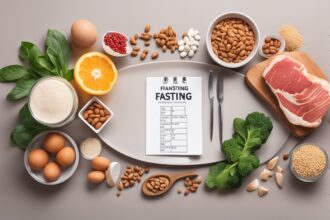Intermittent fasting (IF) has gained immense popularity as a dietary strategy for weight loss, improved metabolic health, and even longevity. However, one of the most common concerns among those practicing IF is how to maintain muscle mass and ensure adequate protein intake while fasting. This comprehensive guide explores the concept of optimizing protein during intermittent fasting, offering actionable tips to help you balance fasting with muscle preservation and overall health.
What Is Intermittent Fasting and Why Does Protein Matter?
Intermittent fasting is an eating pattern that alternates between periods of eating and fasting. Popular methods include the 16/8 method (fasting for 16 hours and eating during an 8-hour window) and the 5:2 diet (eating normally for five days and restricting calories on two non-consecutive days). While IF can promote fat loss and improve insulin sensitivity, it raises concerns about protein intake and muscle maintenance.
Protein is a crucial macronutrient for muscle repair, growth, and overall body function. During fasting, the body may enter a state of gluconeogenesis, where it breaks down protein (including muscle tissue) for energy if adequate reserves or dietary intake are not available. Therefore, optimizing protein during intermittent fasting is essential to prevent muscle loss and support recovery, especially for those who exercise regularly.
How Much Protein Do You Need During Intermittent Fasting?
The Recommended Dietary Allowance (RDA) for protein is 0.8 grams per kilogram of body weight for the average adult. However, for those practicing intermittent fasting, especially if combined with resistance training, higher protein intake—ranging from 1.2 to 2.2 grams per kilogram of body weight—may be necessary to preserve lean muscle mass. This is particularly important during fasting periods when the body might otherwise turn to muscle tissue for energy.
Timing also plays a role. Consuming protein within your eating window can help maximize muscle protein synthesis. Research suggests that spreading protein intake across meals (if your eating window allows for multiple meals) or prioritizing a high-protein meal post-workout can be highly effective. For more insights on protein needs, check out our detailed guide on protein requirements for active lifestyles.
Best Protein Sources for Intermittent Fasting
Choosing high-quality protein sources is key to optimizing protein during intermittent fasting. Since your eating window is limited, you want to prioritize nutrient-dense foods that provide maximum benefits. Here are some top options:
- Lean Meats: Chicken breast, turkey, and lean beef are excellent sources of complete protein with minimal fat.
- Fish and Seafood: Salmon, tuna, and shrimp offer protein along with omega-3 fatty acids for overall health.
- Eggs: A versatile and affordable protein source, eggs are perfect for breaking a fast or as a quick meal.
- Plant-Based Proteins: Lentils, chickpeas, tofu, and tempeh are great for vegetarians and vegans practicing IF.
- Protein Powders: Whey, casein, or plant-based protein powders can be a convenient way to hit your protein goals within a short eating window.
Incorporating a variety of these sources ensures you get all essential amino acids while keeping meals interesting. For recipe ideas, explore our post on high-protein meal ideas for fasting.
Timing Your Protein Intake for Maximum Benefits
One of the biggest challenges with intermittent fasting is fitting enough protein into a condensed eating window. Timing your intake strategically can make a significant difference. If you’re following a 16/8 fasting schedule, aim to break your fast with a protein-rich meal to kickstart muscle protein synthesis. This is especially important if you’ve worked out during or just before your fasting window ends.
For those who train during fasting, consuming 20–30 grams of protein within 30 minutes to an hour after exercise can help with recovery. Additionally, if your eating window allows for multiple meals, try to distribute protein evenly—research shows that 20–40 grams of protein per meal maximizes muscle protein synthesis. Learn more about post-workout nutrition in our article on post-workout nutrition for fasting.
Supplements to Support Protein Optimization During Fasting
Supplements can be a game-changer for those struggling to meet protein needs during intermittent fasting. Protein powders, as mentioned earlier, are a quick and easy option. Whey protein isolate, in particular, is fast-digesting and ideal for post-workout recovery. For a slower release of amino acids (beneficial during fasting periods), casein protein can be consumed before your fasting window begins.
Branched-chain amino acids (BCAAs) or essential amino acids (EAAs) are another popular choice, though their necessity is debated. While they may help reduce muscle breakdown during fasting, whole protein sources are generally more effective. If you’re considering supplements, consult a healthcare professional to ensure they align with your goals. For a deeper dive into supplements, read our guide on supplements for intermittent fasting.
Common Mistakes to Avoid When Optimizing Protein During Fasting
While optimizing protein during intermittent fasting is achievable, there are common pitfalls to watch out for:
- Underestimating Protein Needs: Failing to calculate or track protein intake can lead to inadequate consumption, risking muscle loss.
- Overeating Low-Quality Protein: Relying on processed meats or low-quality protein sources can lead to poor nutrition and health issues.
- Ignoring Hydration: Fasting can increase dehydration risk, and protein metabolism requires adequate water—don’t skimp on fluids.
- Skipping Strength Training: Without resistance exercise, even high protein intake may not fully protect against muscle loss during fasting.
Avoiding these mistakes can help you maintain a balanced approach to IF. For additional tips on fasting success, check out our article on common fasting mistakes to avoid.
Disclaimer: The information provided in this article is for educational purposes only and should not be considered medical advice. Intermittent fasting and dietary changes, including protein optimization, may not be suitable for everyone. Always consult with a healthcare professional or registered dietitian before starting any new diet or exercise regimen, especially if you have underlying health conditions or specific nutritional needs.
References
- Tinsley, G. M., & La Bounty, P. M. (2015). Effects of intermittent fasting on body composition and clinical health markers in humans. Nutrition Reviews.
- Morton, R. W., et al. (2018). A systematic review, meta-analysis and meta-regression of the effect of protein supplementation on resistance training-induced gains in muscle mass and strength in healthy adults. Journal of the International Society of Sports Nutrition.
- Harvard Health Publishing. (2018). Intermittent fasting: Surprising update.
- Schoenfeld, B. J., & Aragon, A. A. (2018). How much protein can the body use in a single meal for muscle-building? Implications for daily protein distribution. Journal of the International Society of Sports Nutrition.
- Mayo Clinic. (2020). Protein: How much do you need?
This content is for informational purposes only and not a substitute for professional advice.






